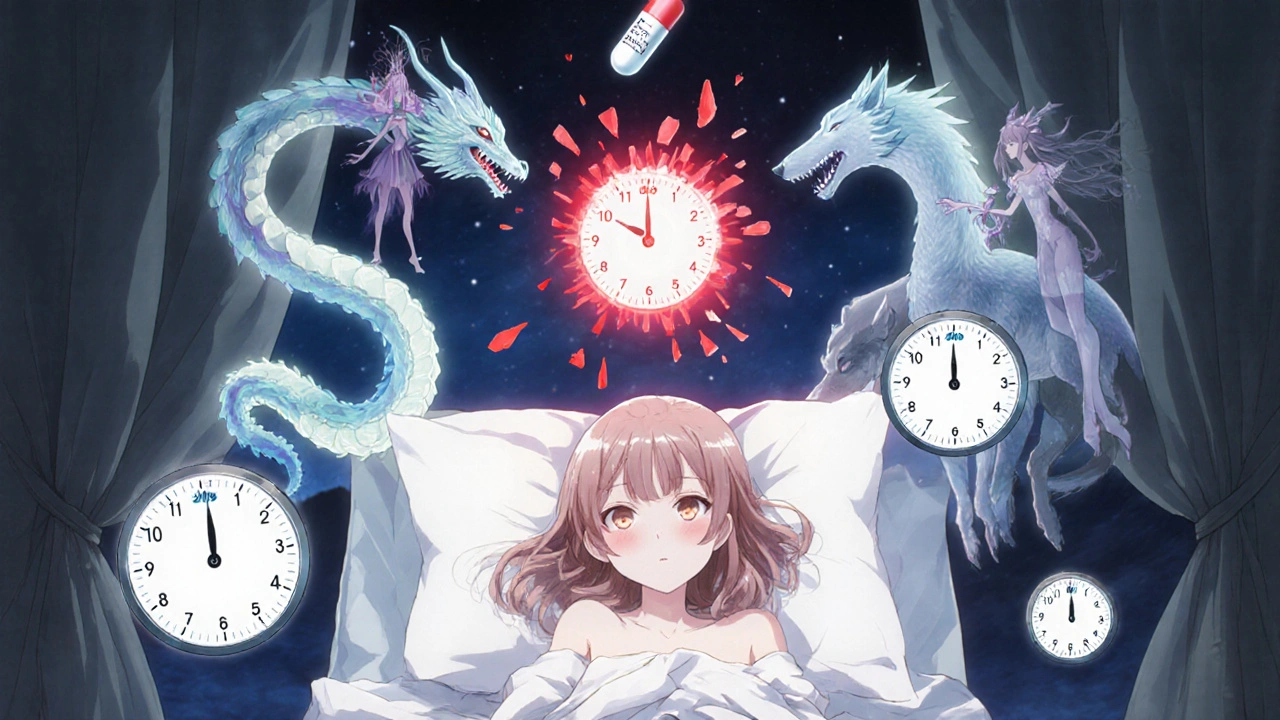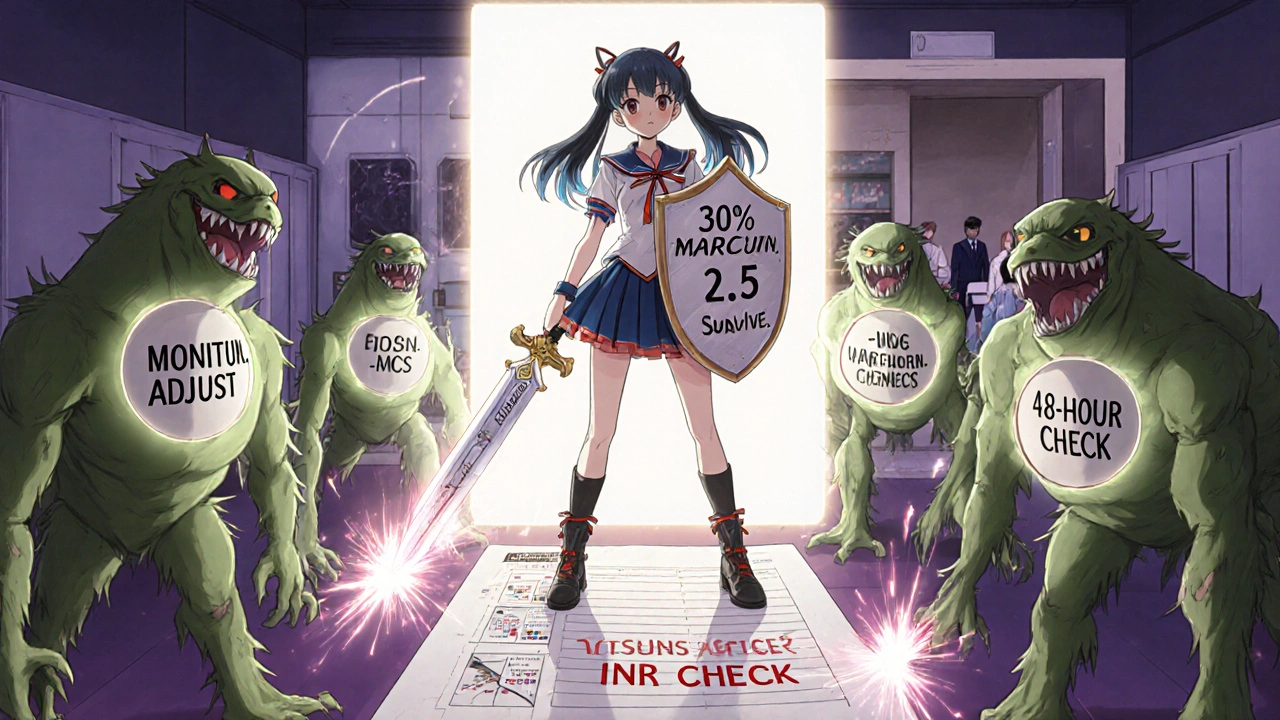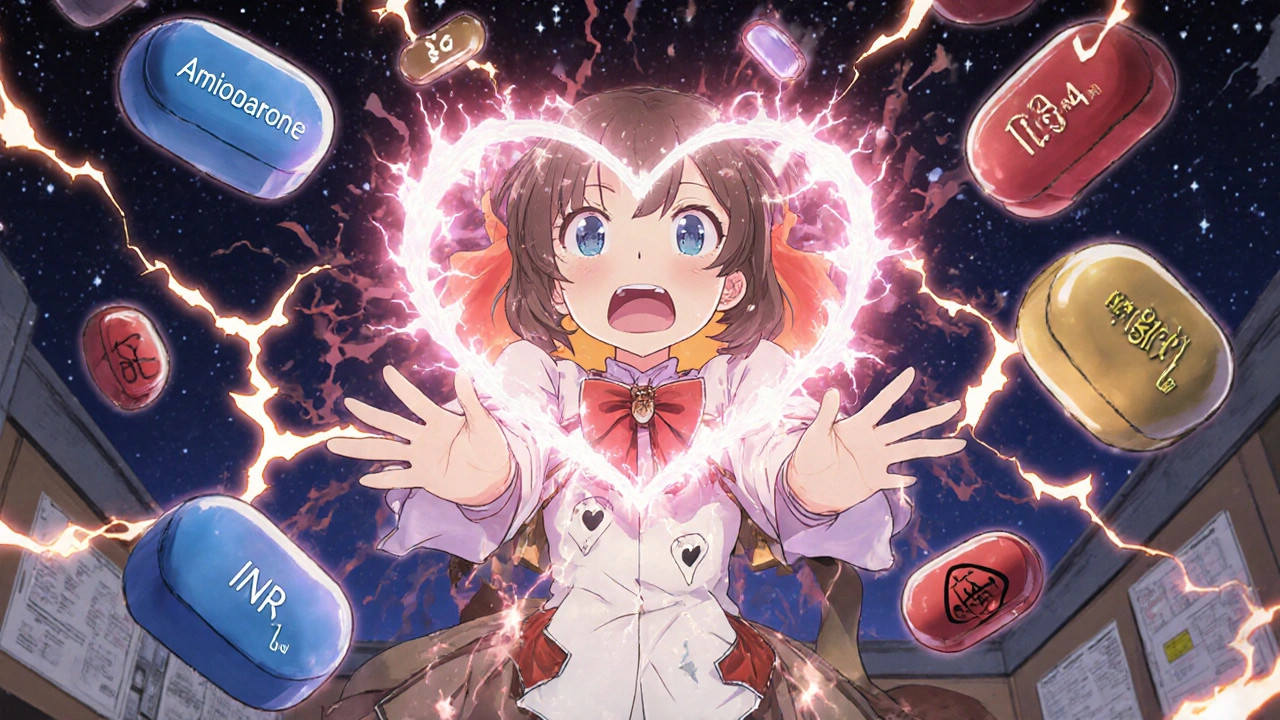Warfarin Dose Adjustment Calculator
Critical Safety Information
WARNING: Amiodarone significantly increases warfarin levels, raising bleeding risk. Do NOT use this calculator as a substitute for professional medical advice.
Per guidelines: Reduce warfarin dose by 30-50% when starting amiodarone. Monitor INR every 48-72 hours for 2 weeks, then weekly until stable. Continue monitoring for 4-6 weeks after stopping amiodarone.
Recommended Warfarin Dose: mg/day
INR Monitoring Schedule:
- • First 2 weeks: Every 48-72 hours
- • After 2 weeks: Weekly until stable
- • Minimum 4-6 weeks after stopping amiodarone
INR Target Range: 2.0-3.0 (must maintain within therapeutic window)
INR ≥ 4.0 = Medical Emergency Risk of fatal bleeding increases dramatically above 4.0. Symptoms include:
- Bruising or bleeding that won't stop
- Dark/tarry stools
- Severe headache
- Unexplained pain
Imagine you’re on three medications meant to keep your heart stable - amiodarone for irregular rhythms, digoxin to slow your pulse, and warfarin to prevent clots. Sounds like a well-planned treatment, right? Amiodarone with digoxin and warfarin is one of the most dangerous combinations in cardiology, and it’s still prescribed every day - often without proper safeguards.
This isn’t theoretical. In 2022 alone, the FDA logged 387 deaths linked to this exact trio. That’s not a rare accident. It’s a predictable outcome when three drugs that each alter the way the others work are thrown together without adjustment. And the worst part? Many doctors don’t realize how long the danger lasts - even after stopping amiodarone.
Why This Triad Is a Perfect Storm
Amiodarone doesn’t just interact with digoxin and warfarin - it amplifies them in ways that are both powerful and long-lasting. Digoxin, a drug used since the 1700s, is already tricky. It has a narrow safety window: too little, and it doesn’t control your heart rate; too much, and it triggers vomiting, visual blurring, and deadly arrhythmias. Warfarin is no easier. It’s a blood thinner that needs constant monitoring. Your INR (a measure of clotting time) must stay between 2.0 and 3.0. Go above 4.0, and you risk bleeding inside your brain or gut. Go below, and you’re unprotected from stroke.
Amiodarone messes with both. It blocks the body’s ability to clear digoxin, causing levels to spike by 40% to 100% within days. At the same time, it shuts down the liver enzymes (CYP2C9 and CYP3A4) that break down warfarin. This means warfarin sticks around longer, making your blood thinner than intended. In some cases, INR levels jump from 2.5 to over 10 in under two weeks - a level that can cause spontaneous bleeding.
And here’s the kicker: amiodarone stays in your body for months. Its half-life? Between 25 and 100 days. So even if you stop taking it, the interaction doesn’t vanish. You’re still at risk for weeks - sometimes over a month - after your last dose.
The Real-World Cost of Overlooking This
In 2020, a study of over 12,000 patients on warfarin found that those also taking amiodarone were more than four times as likely to have dangerously high INR levels. Their risk of major bleeding went up by 180%. One case from Massachusetts General Hospital involved a 78-year-old man whose INR hit 12.4 after starting amiodarone. He needed four units of fresh frozen plasma and a high-dose vitamin K infusion just to stop the bleeding. He survived - but barely.
Digoxin toxicity is equally brutal. The FDA’s adverse event database shows over 1,800 reports of digoxin poisoning linked to amiodarone between 2010 and 2022. That’s not a fluke. That’s a pattern. Elderly patients - especially those with kidney issues - are most at risk. A 2023 review in Circulation: Arrhythmia and Electrophysiology found that patients on both amiodarone and digoxin had a 28% higher death rate than those on digoxin alone. The highest risk? The first 30 days after starting amiodarone.
And it’s not just the drugs themselves. Digoxin is 40% bound to albumin in the blood. When amiodarone pushes up digoxin levels, it can also displace warfarin from protein binding sites, making even more warfarin free and active in your bloodstream. It’s a triple hit: more digoxin, more warfarin, and less clearance of both.
What Should You Do If You’re on This Combination?
If you’re currently taking all three, don’t panic - but do act. This interaction is preventable. The American College of Cardiology and NHS guidelines are clear:
- Reduce digoxin by 50% immediately when amiodarone is started. Don’t wait for symptoms. Don’t wait for a blood test. Cut the dose right away.
- Check your digoxin level 72 hours after starting amiodarone. Normal levels are 0.5-2.0 ng/mL, but for elderly patients, aim for under 1.2 ng/mL. Anything above that is risky.
- Reduce your warfarin dose by 30-50% before or at the same time as starting amiodarone. This isn’t optional. Studies show this cuts the risk of INR spikes by more than half.
- Test your INR every 48-72 hours for the first two weeks. Then weekly until stable. Don’t rely on monthly checks - that’s too slow.
- Keep monitoring for 4-6 weeks after stopping amiodarone. Even if you’ve quit the drug, your body is still processing it. Stopping monitoring too soon is a common cause of late bleeding events.
These steps aren’t suggestions. They’re survival protocols. A 2023 quality improvement program across 47 UK hospital trusts showed that following these rules reduced adverse events by 78%. That’s not a small gain. That’s life or death.

What About Newer Blood Thinners?
Many people now take DOACs - drugs like apixaban, rivaroxaban, or dabigatran - instead of warfarin. They’re easier to use, don’t need regular blood tests, and have fewer food interactions. But here’s the catch: amiodarone still affects them.
Dabigatran, for example, is cleared partly by P-glycoprotein - the same transporter that amiodarone blocks. So even if you’re not on warfarin, adding amiodarone can still raise dabigatran levels and increase bleeding risk. The NHS Specialist Pharmacy Service updated its guidelines in 2023 to warn of this. So if you’re on a DOAC and your doctor adds amiodarone, you still need caution - just not the same level of INR monitoring.
That said, DOACs are safer overall. In 2022, 82% of new atrial fibrillation patients started on a DOAC instead of warfarin. This means the amiodarone-warfarin-digoxin triad is becoming less common - but it’s far from gone. Millions of people still rely on warfarin because they have mechanical heart valves, can’t afford DOACs, or have kidney problems that make DOACs risky.
Genetics Can Make It Worse
Not everyone reacts the same way. A 2023 study in Clinical Pharmacology & Therapeutics found that people with a specific gene variant (ABCB1 C3435T TT genotype) had nearly 92% higher digoxin levels when taking amiodarone. Others with a different variant saw only a 58% increase. This means two people on the same doses could have wildly different outcomes.
Right now, genetic testing for this isn’t routine. But if you’ve had unexplained digoxin toxicity or bleeding on this combo - even after dose adjustments - it’s worth asking your doctor about pharmacogenetic testing. It might explain why things went wrong.

What You Should Ask Your Doctor
If you’re on any of these drugs, don’t wait for your doctor to bring it up. Ask these questions:
- “Am I on amiodarone, digoxin, and warfarin? If so, has my dose been adjusted?”
- “When was my last digoxin level checked? What was the result?”
- “Have my INR levels been checked more than once a week since I started amiodarone?”
- “If I stop amiodarone, how long should I keep monitoring?”
- “Could I switch to a DOAC instead of warfarin?”
Doctors are busy. But this interaction is so dangerous that it’s been called one of the most preventable causes of iatrogenic harm in cardiology. If your doctor hasn’t brought it up, you need to.
Final Reality Check
This isn’t a rare edge case. It’s a common, deadly trap. Over 4.3 million Americans are expected to still be on this combination by 2030. That’s not because it’s safe - it’s because alternatives aren’t always available. The FDA’s 2023 Drug Safety Communication added a Black Box Warning to amiodarone specifically because of this triad. That’s the strongest warning they give.
If you’re on these three drugs, you’re in a high-risk zone. But you’re not helpless. With the right dose adjustments, frequent monitoring, and awareness of the timeline - you can avoid disaster. The science is clear. The guidelines exist. What’s missing is consistent action.
Don’t assume your doctor knows. Don’t assume your pharmacist caught it. Don’t assume you’re fine because you feel okay. This interaction doesn’t cause symptoms until it’s too late. By the time you feel sick, your INR could already be at 8. Your digoxin level could already be poisoning your heart.
Knowledge isn’t just power here. It’s your only shield.




Sean Hwang
man i had a buddy on this combo last year. doc didn't adjust anything. he ended up in the er with a bleed. luckily he lived but now he's on apixaban and zero digoxin. just say no to the triad.
Peter Aultman
this is the kind of post that should be pinned everywhere. i'm a med tech and i've seen this happen way too often. docs get lazy and assume the patient's fine because they're not screaming. but the numbers don't lie. check the INR. check the digoxin. don't wait.
gent wood
Thank you for writing this with such clarity. I’ve worked in cardiology for over two decades, and I still see this combination prescribed without the necessary adjustments. The half-life of amiodarone is the silent killer here. Many clinicians forget that its effects linger long after discontinuation. The guidelines are clear, but implementation is inconsistent. We need mandatory alerts in EHR systems, not just recommendations.
Don Ablett
amiodarone is a beast i dont understand why it is still used when there are alternatives like dronedarone or sotalol that dont wreck your liver and kidneys and every other system in your body
Eleanora Keene
if you're on this combo and you're feeling off even a little bit - nausea dizziness weird vision - don't wait until your next appointment. go to urgent care. get your levels checked. your life is worth more than a waitlist. i've seen too many people brush it off until it's too late. you're not being dramatic. you're being smart.
Brittany C
the pharmacokinetics here are fascinating. amiodarone inhibits CYP2C9 and CYP3A4, which are the primary enzymes responsible for warfarin metabolism, while simultaneously reducing renal clearance of digoxin via P-gp inhibition. the synergistic effect on protein binding displacement further exacerbates free drug concentrations. this isn't just an interaction - it's a pharmacological cascade.
Kevin Wagner
THIS IS WHY WE NEED TO STOP LETTING DOCTORS GUESS. THIS ISN'T COMPLICATED. REDUCE DIGOXIN. REDUCE WARFARIN. MONITOR LIKE YOUR LIFE DEPENDS ON IT - BECAUSE IT DOES. IF YOUR DOCTOR DOESN'T KNOW THIS, FIND A NEW ONE. NO EXCUSES. WE’RE TALKING ABOUT LIVES HERE.
Jane Johnson
Why are we still using amiodarone at all? It's basically a chemical grenade with a 100-day fuse. The fact that it's still first-line for some patients is a scandal. And don't get me started on how many elderly patients are just given this combo because 'it's what they've always done.' This isn't medicine. It's negligence dressed in a white coat.
Joe Goodrow
we dont need more warnings. we need more accountability. if a doctor prescribes this without adjusting doses and monitoring, they should lose their license. period. this is not a gray area. this is murder by omission.
Dilip Patel
in india we see this all the time. doctors give amiodarone because its cheap and digoxin because its old and warfarin because its everywhere. no testing no followup. old people die quietly in villages. nobody cares. the system is broken
Anjan Patel
you think this is bad wait till you hear about the guy who took all three and then went on a cruise and drank grapefruit juice. his INR went to 15. they had to fly him back on a medevac. his wife cried for three days. he still has nightmares about the IV bags. this isn't a drug interaction. this is a horror story with a prescription pad.
Sean Evans
😭😭😭 this is why i stopped trusting doctors. my grandma died from this. they told her it was "normal" to feel dizzy. she had a stroke because her INR was 11.5 and no one checked for 6 weeks. now i check my own blood every week. if you're not doing that, you're playing russian roulette with your heart. 🚨💊
Scott Saleska
actually i think you're overstating this. i've seen patients on this combo for years with no issues. sure, you need to monitor, but it's not a death sentence. maybe the real problem is overtesting and overreacting. not every interaction leads to disaster. let's not scare people into abandoning a drug that saves lives when used properly.